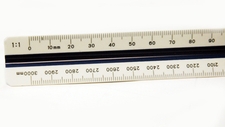Metric Measurements

TEKS Objective
The student is expected to collect, record, and analyze information using tools, including calculators, microscopes, cameras, computers, hand lenses, metric rulers, Celsius thermometers, prisms, mirrors, pan balances, triple beam balances, spring scales, graduated cylinders, beakers, hot plates, meter sticks, magnets, collecting nets, and notebooks; timing devices, including clocks and stopwatches; and materials to support observation of habitats of organisms such as terrariums and aquariums.
Essential Understanding
The student knows how to use a variety of tools, materials and methods to conduct science inquiry.
Science Background
Tools and Equipment of Science: BioEd Online (video) - Introduce students to important science tools, such as metric rulers, thermometers and magnifiers.
Tools and Equipment of Science
BioEd Online, www.bioedonline.org
Origin of the Metric System: US Metric Association - This site explains the origins and growth of the metric system, the world’s most commonly used and accepted set of units for measurement.
Origin of the Metric System
US Metric Association
SI Measurement: Holt, Rinehart and Winston Co. (PDF) - This reference chart identifies the basic units of the International Systems of Units (SI), or metric system, including prefixes used to define smaller and larger quantities. It also includes a conversion table for SI to English (or standard) measurement.
Signature Lesson
Metric Madness: BioEd Online (website) - While rotating through a series of stations, students collect, record and analyze information by using tools of metric measurement. This lesson may be adjusted depending on measurement objectives of the grade level.
- Supporting Lessons
- Extensions
- Assessment Ideas
- Literature Connections
- Related
TEKS - Additional Resources
Supporting Lessons
What’s Your Wingspan? Science NetLinks (website) - Students gather, graph and analyze data related to their “wingspans” in this exercise on measurement. Includes assessment and extensions.
What's Your Wingspan?
Science NetLinks, www.sciencenetlinks.com
Estimation and Measurement: Science NetLinks (website) - Learn to estimate and measure using conventional and unconventional (non-standard) units.
Estimation and Measurement
Science NetLinks, www.sciencenetlinks.com
Elaboration Lessons and Extensions
Balloon Blast: BioEd Online (website) - Students devise a plan to measure the distance of a balloon's flight and predict the direction a balloon will travel as it deflates. The activity introduces students to Newton's Third Law (for every action there is an opposite, yet equal, reaction) and requires them to collect relevant data, graph results, and draw conclusions.
Assessment Ideas
Have students measure the “wingspan” of their family members (see Supporting Lessons, above), and compare wingspan to height. Ask students if they notice any patterns between the two measurements, and have each student write a paper about his/her observations.
Literature Connections
How Big is the Lion? Accorsi, William (ISBN-13: 978-0761155409)
Measuring Penny. Leedy, Loreen (ISBN-13: 978-0805065725)
How Big is a Foot? Myller, Rolf (ISBN-13: 978-0440404958)
Me and the Measure of Things. Sweeney, Joan (ISBN-13: 978-0440417569)
Length. Pluckrose, Henry (ISBN-13: 978-0516454535)
Additional Resources
Metric Mania Lesson Plans: The Science Spot (website) - A host of metric lessons that include labs on length, mass, volume, density, temperature and conversions.
Metric Mania Lesson Plans
The Science Spot, www.sciencespot.net
Create a Graph: Kids’ Zone (website) - Easy-to-use resource from the National Center for Education Statistics that enables students to create and print five types of graphs, in various patterns and colors, for use in experiments. You can even title the graph and label the axis.
TEKS Navigation
Grade 5
Need Assistance?
If you need help or have a question please use the links below to help resolve your problem.

Comments